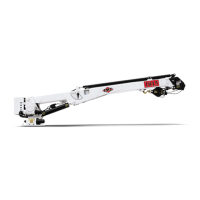99903514:TELESCOPIC CRANE: 3-3 SECTION 3: REPAIR
3-4: CLEANLINESS
Keep dirt out of working parts to preserve the life
of the crane. Enclosed compartments, seals,
and filters have been provided to keep the air
supply, fuel, and lubricants clean. Maintain
these enclosures.
When any hydraulic oil, fuel, or lubricating oil
lines are disconnected, clean the adjacent
areas as well as the connection point. Once
disconnected, cap, plug, or tape each line to
prevent foreign material entry.
Clean and inspect all parts, and cover them
once clean. Be sure all passages and holes are
open. Install clean parts and leave new parts
packaged until assembly.
3-5: HYDRAULIC SYSTEM
The hydraulic system must be clean. Contami-
nants in the hydraulic system affect operation
and can cause component damage. When
working on the hydraulic system:
NEVER
- Allow foreign material including dirt, metal
particles, or water to enter the hydraulic
system. Cap all connections. If you find
evidence of foreign particles, flush the
system and replace filters.
ALWAYS
- Relieve hydraulic pressure.
- Inspect all seals during assembly and
disassembly. IMT recommends installing
new seals after hydraulic system repairs.
- Position hoses so they don’t rub on the
crane or other hoses. Maintain natural hose
curvature.
- Clean hydraulic components prior to assem-
bly, using an appropriate solvent and follow-
ing manufacturer precautions. Disassemble
and assemble components on a clean
surface.
- Cycle all controls after repair to eliminate
trapped air and alleviate erratic movement.
- Check for hydraulic leaks after repair. A
high-pressure leak is hazardous and must
be repaired prior to putting the unit back in
service.
WARNING
USE CLEANING SOLVENTS ONLY IN A
WELL-VENTILATED AREA WITH FIRE
EXTINGUISHERS READILY AVAILABLE.
3-6: FASTENERS & TORQUE VALUES
BOLTS: Use bolts of the correct length so the
bolt does not bottom out and enough threads
are engaged.
Torque values correspond to the bolts, studs,
and nuts used. Use hardened washers when
torquing nuts or bolts.
Identification of fastener grades is necessary.
When marked as a high grade bolt (grade 5, 8,
etc.) the mechanic must be aware he is working
with a highly stressed component, and the
fastener should be torqued accordingly.
Figure C-1: Fastener Grade
Identification
WARNING
USE OF FASTENERS OTHER THAN THE
GRADE SPECIFIED CAN CAUSE PER-
SONAL INJURY OR EQUIPMENT FAILURE.
IF A MOUNTING BOLT IS REMOVED,
ALWAYS REPLACE IT WITH A NEW BOLT
OF THE SAME GRADE.
When the maximum recommended torque
value has been exceeded, replace the fastener.
NOTE
TEMPERATURE VARIATION, VIBRATION,
AND METAL ELASTICITY CAN RESULT IN
THE GRADUAL REDUCTION OF BOLT
TORQUE. RE-TORQUE BOLTS AS
OUTLINED IN THE INSPECTION PROCE-
DURES.
20030115

